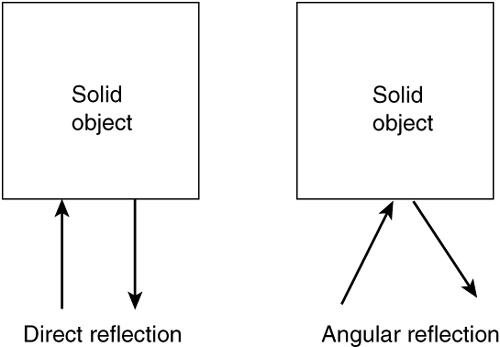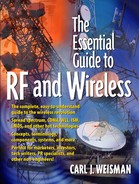RF IN THE ENVIRONMENT
Signal Behavior
Skin Effect
As you have already learned, RF signals are either on a conductor or flying around as waves in the air. When an RF signal is on a conductor, which is just about any piece of metal, it only hangs out on the surface of the metal object itself. Picture a solid piece of metal the shape of a brick. If an RF signal were placed on the brick, the signal itself would only be present on the surface of the brick, none would venture inside. If a detector could somehow be placed inside the brick, it would not detect the presence of the RF signal. This behavior exhibited by RF signals is called the skin effect, which is self-explanatory.
The reason the skin effect occurs is simple to understand, if you have a degree in electrical engineering. But since the assumption is that you don't have an engineering degree—or you are an engineer with too much free time—I will explain the skin effect as follows. RF signals have a natural inclination to want to escape solid objects and fly around in the air, but for reasons which will be explained later, they cannot always do it. The next best thing these restless RF signals can do is to get as close to the outside of whatever it is they are on in the hope of ultimately escaping and fulfilling their true destiny: to be detected by aliens from another galaxy.
Absorption
Once an RF signal does escape the bounds of a conductor and flies around in the air, just about everything it encounters changes it in some way. These changes tend to do one of two things to the RF signal: they either make it smaller or change the direction in which it is traveling.
Most of the "things" the RF signal encounters tend to make the signal smaller, including the air we breathe, rain, glass, wood, and even foliage. In a very real sense, all of these "things" can be viewed as types of passive devices with some amount of insertion loss (expressed in dB, of course). This insertion loss exhibited by things in nature is called absorption, because it absorbs the RF signal.
A perfect example to demonstrate absorption is the effect rain has on direct-to-home satellite TV, which is predominantly in the Ku-Band. It just so happens that the size of the RF signal carrying direct-to-home satellite television is just about the size of an average raindrop, which makes the conditions ideal for absorption. When the weather is clear, the signal makes it to the receiver with only nominal loss and everything is fine. But when it starts to rain, some of the signal gets absorbed by the rain and, therefore, less of it finds its way to the little satellite dish on the roof. During instances of very heavy rain, it is entirely possible that absorption will be severe enough to wipe out the signal, leaving the direct-to-home satellite TV service out of order. This situation is not something the service providers advertise, but it is something you should be aware of if you live in, say, Seattle.
At the risk of insulting you, when an RF signal experiences loss as it travels through a rainstorm, where does the lost energy go? HEAT! Believe it or not, the rain actually warms up. Of course the rise in temperature is so small it is difficult to measure, not to mention the darn raindrop would probably evaporate before you could get out the thermometer.
Even the air we breathe absorbs RF energy as it travels, which explains why RF signals cannot travel forever and why a cellular phone call drops out when the mobile unit strays too far from a basestation. Now for the $64,000 question. When does a cellular phone have the greater call range, on a sunny day or on a rainy day? I will leave the answer up to you.
Did You Know?
Absorption explains exactly how your microwave oven works. An RF signal is radiated inside the microwave oven at a frequency that water really likes to absorb. As the RF signal encounters the water, the signal gets smaller and the water gets hotter. That is why objects with no water content will not get hot inside your microwave oven
Reflection
Not everything an RF wave encounters absorbs RF energy. Some things which RF waves encounter send the RF signal in another direction. This change of direction is called reflection. As an approximation, RF signals tend to reflect off objects at the same angle at which they encounter them (see Figure 2-5).
Figure 2-5. Direct and angular reflection.

Many objects reflect, at least partially, RF signals which hit them. The amount of reflection depends on two things: the frequency of the RF (of course), and the material of the object. Some materials reflect RF energy only moderately, like concrete, while others reflect it completely, like metal. For materials which only partially reflect the RF wave, what do you suppose happens to the rest of the signal? I'll give you a hint. Go back a few paragraphs to the one which contains the word absorption. Now you've got it. When an RF signal hits any material, the RF energy either gets completely absorbed (like water), partially absorbed and partially reflected (like concrete), or completely reflected (like metal). Congratulations, you now understand RF behavior.
